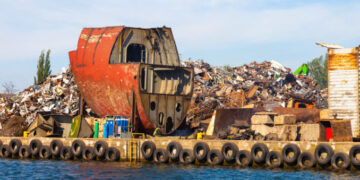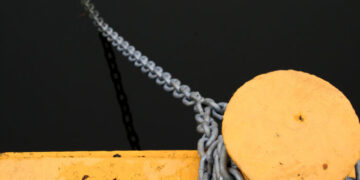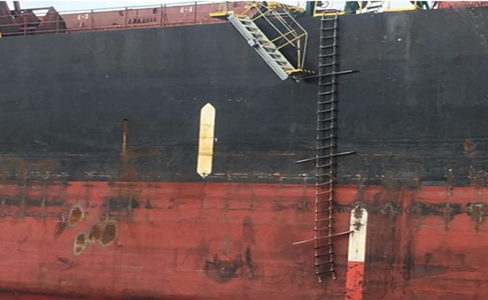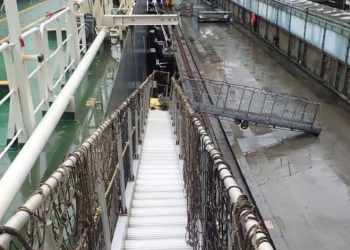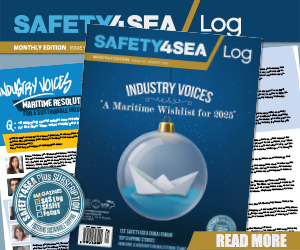RightShip presents four different case studies to highlight an alarming trend has emerged from incident & inspection data over the last two years with regards to ladders and pilot transfer arrangements.
The organization has observed several deficiencies while the ladders are not in use. However, critically, it is when an inspector is not present, and ladders are being rigged or utilised, that those deficiencies with high-risk potential can result in incidents, RightShip notes providing the following cases:
Case (1) Summary of events:
A ship in normal ballast was completing its pilotage transit out of port on a relatively calm winter morning. The pilot ladder was rigged according to the pilot’s request and the Chief Officer escorted the pilot down from the bridge. Once the pilot boat was safely alongside, the pilot started his descent. When he was about two meters down, a side rope parted, and the ladder swung violently causing the pilot to fall the approximately 5 meters into the icy waters. The pilot was recovered and was treated for shock. Upon reviewing the records, it was discovered that the monthly safety equipment inspection had recently been completed, including the pilot ladder, and which was documented as in satisfactory condition.
Case (2) Summary of events:
As the freeboard was over 9 meters, the crew of a light tanker rigged a combination ladder in preparation for the harbour pilot to board. When the launch came alongside, everything looked in order and the pilot started his ascent to the main deck. As the pilot boat pulled away from the ship, a retrieval line attached to the bottom step caught on one of the launch’s cleats and pulled the ladder away from the side of the ship which caused it to part. The pilot, who was still climbing the ladder fell from height into the water. To complicate matters further, part of the broken ladder attached to the launch fell into the water and subsequently fouled the propellor, causing a delay in rescue efforts. When the pilot was finally recovered, he had to be treated for a serious head injury.
Case (3) Summary of events:
A laden tanker with 11.45 m draft was underway in the Mediterranean Sea, en route to the discharge port. The weather conditions were reported as favourable with light South-easterly winds, good visibility, with air temperature at 15 degrees C and sea temperature at 16 degrees C. At 0500, instructions were received to prepare a combination pilot ladder arrangement on the port side for pilot boarding. Risk assessment was completed, and a toolbox meeting held by the vessel’s Master with the experienced Bosun and AB. The 4th Officer, the Officer of the Watch, monitored the operation from the bridge wing, while the Master had the conn.
Case (4) Summary of events:
Early morning, a bulk carrier dropped anchor in preparation for a Ship-to-Ship cargo operation in the Bay of Bengal. After the lightering vessel had come alongside, an agent, several surveyors, and other representatives boarded the Ship to be Lightered (STBL) to complete pre-transfer draft surveys during which Yokohama fenders were fitted between the ships. Discharging commenced mid-morning. Approximately 45 minutes after cargo operations began, paperwork was finalized and one of the surveyors and the other attending personnel disembarked over the shipside railing and onto the fender of the lightering vessel. One surveyor, reportedly an experienced mariner, was disinclined to disembark in a similar fashion and requested the pilot ladder be rigged between the STBL and the lightering vessel. Once the pilot ladder was in place, the 3rd Officer of the STBL observed the lateral distance, which was approximated at 1.5m, and decided the safer approach was to rig a combination ladder. The surveyor did not consider the gap to pose a significant risk and insisted that the pilot ladder be pulled tight by the lightering vessel. Allegedly, he also refused to don a safety harness.
What went wrong?
Below is a list of root causes and/or contributing factors that have been sighted in investigation reports following Port State Control deficiencies or incidents:
- Inadequate Leadership.
- Inadequate Supervision.
- Substandard Equipment.
- Lack of procedures.
- Lack of familiarization with procedures.
- Failure to follow procedures.
- Lack of training.
- Positive reinforcement of negative behaviour.
- Lack of Situational Awareness.
- Failure to store pilot ladder correctly allowing exposure to the elements.
- Complacency i.e., “Rigging pilot ladder is routine job.”
- Improper decision making.
- Failure to properly and accurately assess risk involved with the task.
- Safety Culture and Attitude lacking.
- Failure of crew members of all ranks to exercise Stop Work Authority.
The following policies, actions, and best practices have been observed being implemented to manage safe personnel transfers:
- Certified Equipment from Reputable Manufacturer – Outfitting vessels with quailty equipment from a reputable manufacturer ensures that ladders meet regulatory standards and demonstrates the company’s commitment to welfare of the personnel utilizing them.
- Maintenance, Stowage, and Testing – The International Organization for Standardisation (ISO) published a three-part series outlining in depth standards regarding pilot ladders. Additionally, reputable suppliers provide manuals that provide detailed instructions regarding the inspection, maintenance, drying process, and storing of the ladders. As with the regulations on pilot ladders, we have seen some managers incorporate the ISO standards and/or the manufacturer recommendations into the PMS, inspection procedures, and training for officers and crew.
- Ladder Service Life – Properly maintained ladders have a finite lifespan and, although there is no specific retirement age defined by regulation, some managers have adopted industry best practice to replace pilot ladders every two years.
- Risk Assessment for Critical Tasks – Rigging pilot ladder accommodations is considered critical and a task-specific Job Safety Analysis that identifies risks and mitigation measures is carried out prior to every operation, no matter the frequency.
- Training – In addition to detailed procedures, effective managers provide thorough initial instruction followed by regular refresher training for reinforcement. Training effectiveness is essential, and good operators routinely provide remedial training when a vessel has pilot ladder related non-conformities identified during inspections.
- Supervision – All inspections, maintenance, rigging, and personnel transfers are overseen and checked by a trained officer. This officer also ensures that applicable PPE is donned throughout the process.
- Two-person Verification – An industry best practice observed is that good managers implement two-person verification. This is a process where two trained individuals capable of detecting faulty equipment or improper rigging check pilot ladder arrangements prior to the transfer of personnel.
- Stop Work Authority (SWA) – Safety conscious managers not only empower crew members of all ranks to stop work when the conditions are unsafe without retribution, they make it their responsibility and obligation.
- Clearance under the combination ladder – It is important to allow a free space of more than 5 meters under the lower platform of the accommodation ladder, to let the pilot boat come alongside safely.













